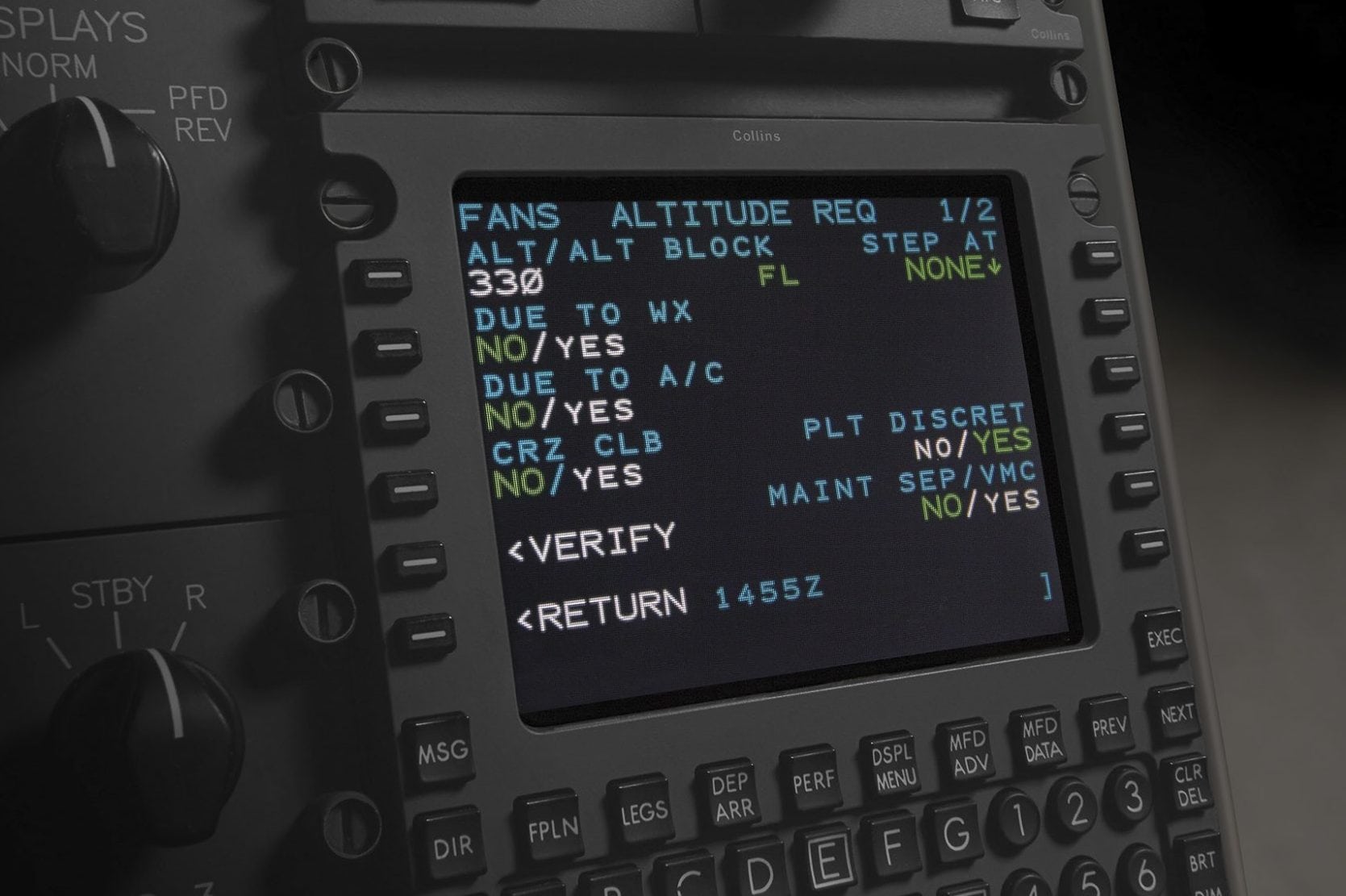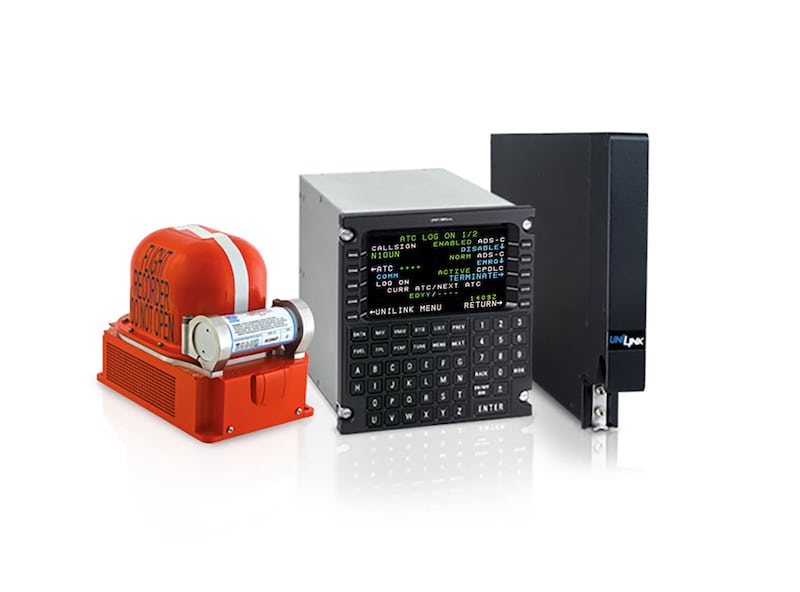
CDU FANS Screen (Rockwell Collins)
It all started years ago with a push by airlines to increase traffic across the North Atlantic by using avionics upgrades and regulatory approval to reduce the vertical and lateral separation of aircraft.
The avionics upgrade, geared mainly toward airlines and upper-tier business aircraft, is part of a two-step mandate to implement the future air navigation system (FANS 1/A) along the North Atlantic organized track system (NAT-OTS). NAT-OTS consists of at least six tracks whose exact positions depend upon prevailing winds and change daily. FANS 1/A provides aircraft data link communications with ATC through satcom via Inmarsat or Iridium satellites or very high frequency.
Part 1 of FANS 1/A requires aircraft flying between flight level 350 and FL390 in the NAT-OTS be equipped with performance-based communications and surveillance (PBCS) equipment by December 2017, which adheres to ICAO standards.
The overall objective of FANS 1/A is to enhance communications, surveillance and ATC capabilities as well as safety in the NAT region. An equally important goal is to reduce the longitudinal separation minimum by 5 minutes in-trail and lateral separation minimum by half a degree (30 nm), according to Carey Miller, director of business development for Universal Avionics.
Much of the formative work on FANS 1/A implementation involved the North Atlantic systems planning group (NAT SPG), the regional organization charged with monitoring air navigation systems in the North Atlantic region. Members of the NAT SPG hail from ICAO member states, which provide service in the North Atlantic air navigation region. Members include Canada, Denmark, France, Iceland, Ireland, Norway, Portugal, UK and the US. NAT SPG also includes ICAO- recognized observers from international organizations, including IATA, IFALPA and IBAC.
Part 2 of FANS 1/A requires aircraft Controller Pilot Data Link Communications (CPDLC) capability between ATC and cockpit. In time, all aircraft flying above FL290 will need FANS equipment throughout the entire NAT region.
The NAT region is implementing the data link mandate (DLM) portion in phases, according to an FAA spokesman. At present, the program is in Phase 2B, which requires FANS 1/A or equivalent systems throughout the entire NAT region on FL350 – FL390. The final phase begins January 2020, from FL 290 and above.
The equipage numbers, said FAA, are targets for data link based on the ICAO Aviation System Block Upgrade (ASBU) Block 0. The objective is for 90% of all aircraft operating in the NAT to be equipped with FANS 1/A at altitudes above FL 290 and 95% by 2020.
In some ways, FANS 1/A in the NAT-OTS can be viewed as a beta test for its acceptance and implementation elsewhere in the world.
“FANS is being implemented at varying rates in multiple regions of the world, and currently that capability is most beneficial for trans-Atlantic flights,” said Heidi Williams, air traffic services director for the National Business Aviation Association (NBAA).
Several airlines have met FANS requirements for their widebody airliners flying the NAT-OTS but hard numbers are difficult to come by. Of the 1,200 to 1,400 daily flights across the Atlantic, most of which are widebody airliners, more than 60% of the aircraft are FANS compliant, according to MRO Duncan Aviation. Business jets make up about 5% to 6% of this daily traffic, a figure which is slowly increasing.

(Universal Avionics Systems Corp.)
FANS was first developed in the early 1990s as a communications and surveillance enhancement for the Boeing 747-400 in oceanic and remote airspace, and later on Airbus equipment. Eventually, this led to FANS 1/A, which utilizes aircraft communications addressing and reporting system (ACARS), satcom, or high radio frequency to facilitate communications between ATC and aircraft.
The newer FANS-compliant aircraft GPS reporting, which allows aircraft to fly closer together. Those aircraft flying with legacy avionics systems don’t provide tracking data and must take less efficient routes around the NAT-OTS. Aircraft crossing the North Atlantic north of the data link-mandated NAT-OTS airspace could add 1.5 hours or more to a crossing at Mach 0.8, according to NBAA. In some cases, eastbound and westbound business aircraft would have to refuel in Reykjavik, Iceland or Gander in Canada.
Apart from getting better communications and positioning, there are numerous other benefits to FANS. The operator or pilot can utilize FANs for departure clearances at several major airports. Universal Avionics’ FANS solution provides the option to upgrade software and add the ATN-B1 message set for the European Data Link Services mandate in 2020. It also includes a VDL Mode 2 radio that meets the domestic multi-frequency requirement of TSO-C160a.
Outfitting oceanic-capable business aircraft with FANS 1/A will likely increase the resale value of older medium-sized and larger business jets, according to MROs.
While acceptance of FANS 1/A as a real-time tool was difficult, Iridium said its problems with signal latency, initially raised by Honeywell, have been solved.
“We modified our system to enable more precise control over the FANS messages, given the specific instances that occurred,” said Michael Hooper, Iridium’s director of aviation. “We developed, tested and launched into production the required modification in about 7 days.”
Iridium, which has a constellation of 66 cross-linked satellites in low-earth orbit, began replacing its complete satellite network in 2017. The company is building its NEXT satellites, which will comprise the same number of active satellites with more orbiting in reserve and others ready to be launched.
Hooper said Iridium NEXT is “fully compatible with existing (legacy) devices, which will continue to function as expected.” Taking advantage of the faster broadband speeds offered by Iridium Certus, however, will require new antennas.
As for the future, “FANS-1A will eventually ‘morph’ into just CPDLC-only and eliminate current position reports (ADS-C),” said Greg Francois, ATR avionics sales manager for Honeywell. “With the Iridium NEXT constellation, the ADS-B receivers onboard each satellite will allow for 100% coverage of all aircraft at all worldwide locations with precise position information from the order of minutes, as is the case today with the ADS-C function of FANS 1/A.”
Honeywell said it would offer dual satcom systems for next-generation airliners and top-tier business aircraft. Dubai-based Emirates selected Honeywell to supply its Aspire 350 Iridium Certus Safety Services voice and data system and the Aspire 400 for the carrier’s Boeing 777X aircraft. Airbus also plans to have dual sitcom installations for long-range communications.
“My belief is that we are talking about the end of HF for long-range communications on new aircraft around the middle portion of the next decade,” said Francois.